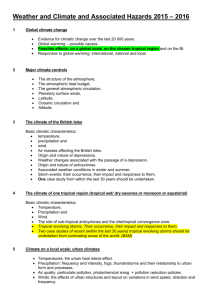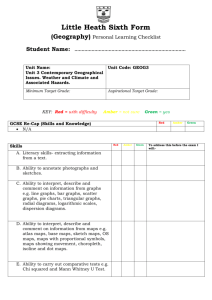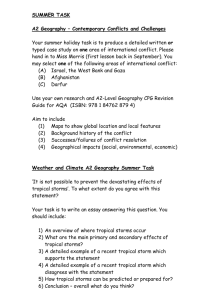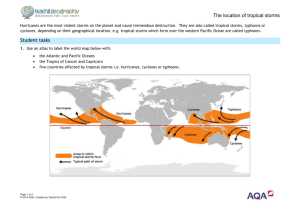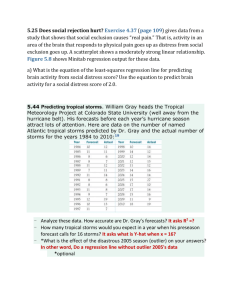AQA A Level Geography Atmosphere checklist
advertisement
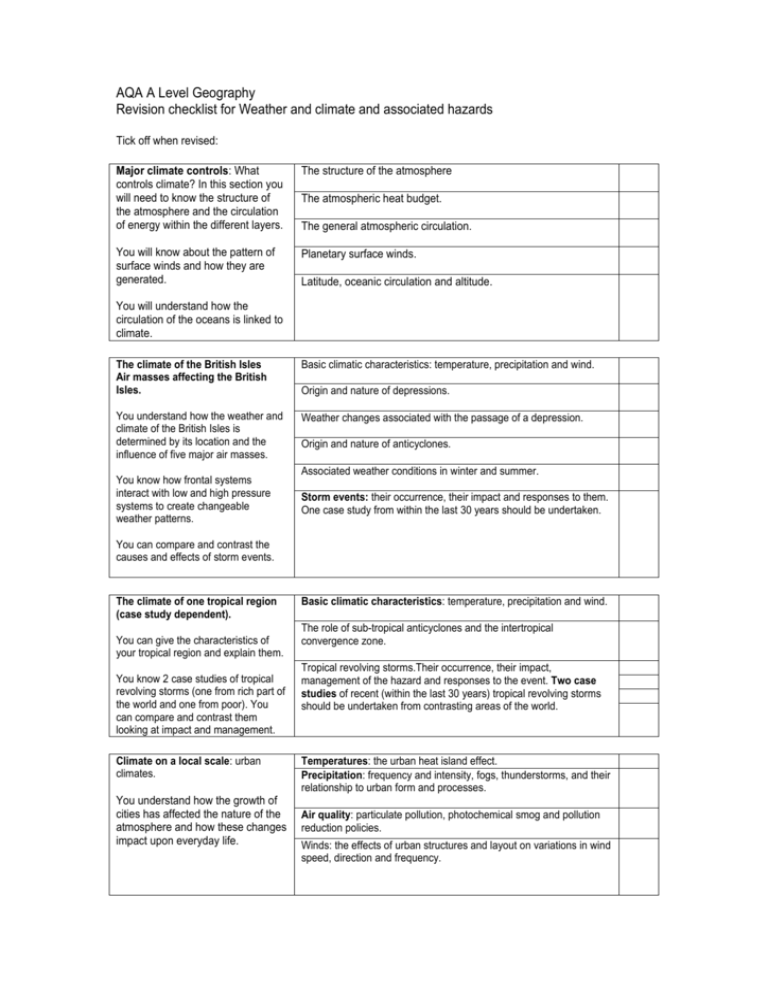
AQA A Level Geography Revision checklist for Weather and climate and associated hazards Tick off when revised: Major climate controls: What controls climate? In this section you will need to know the structure of the atmosphere and the circulation of energy within the different layers. The structure of the atmosphere You will know about the pattern of surface winds and how they are generated. Planetary surface winds. The atmospheric heat budget. The general atmospheric circulation. Latitude, oceanic circulation and altitude. You will understand how the circulation of the oceans is linked to climate. The climate of the British Isles Air masses affecting the British Isles. Basic climatic characteristics: temperature, precipitation and wind. You understand how the weather and climate of the British Isles is determined by its location and the influence of five major air masses. Weather changes associated with the passage of a depression. You know how frontal systems interact with low and high pressure systems to create changeable weather patterns. Origin and nature of depressions. Origin and nature of anticyclones. Associated weather conditions in winter and summer. Storm events: their occurrence, their impact and responses to them. One case study from within the last 30 years should be undertaken. You can compare and contrast the causes and effects of storm events. The climate of one tropical region (case study dependent). You can give the characteristics of your tropical region and explain them. You know 2 case studies of tropical revolving storms (one from rich part of the world and one from poor). You can compare and contrast them looking at impact and management. Climate on a local scale: urban climates. You understand how the growth of cities has affected the nature of the atmosphere and how these changes impact upon everyday life. Basic climatic characteristics: temperature, precipitation and wind. The role of sub-tropical anticyclones and the intertropical convergence zone. Tropical revolving storms.Their occurrence, their impact, management of the hazard and responses to the event. Two case studies of recent (within the last 30 years) tropical revolving storms should be undertaken from contrasting areas of the world. Temperatures: the urban heat island effect. Precipitation: frequency and intensity, fogs, thunderstorms, and their relationship to urban form and processes. Air quality: particulate pollution, photochemical smog and pollution reduction policies. Winds: the effects of urban structures and layout on variations in wind speed, direction and frequency. Global climate change. Evidence for climatic change over the last 20 000 years. You will understand why global warming is considered to be the major environmental threat to life on the planet. Global warming – possible causes. Possible effects: on a global scale, on the chosen tropical region (above) and on the British Isles. Responses to global warming: international, national and local. You will know how governments and people act locally, nationally and internationally to reduce the negative impacts climate change may have. Use the checklist on page 82 of the AQA Geography text by Smith and Knill. This list gives a good overview of the chapter. You are expected to spend at least 200mins a week independent study on this subject. To reach top grades you will need to read around the subject. Ensure you read and make notes from other text books, webpages and other sources of information from the library. Exam questions: You will have the choice in the exam to answer a structured question or essay question on the Weather topic. You cannot answer both. For example a structured question may look like this. June 2013 As you can see the exam paper is different to the AS one. You will write your answers in a booklet provided with the exam paper. Questions are of higher value and there are no low value mark questions. There is always a figure in the structured question, which they will ask you about. The essay style question may look something like this. June 2013 Again you will answer in the booklet provided and select your essay question from all the topics you have studied. There will be a generic mark scheme for all essay answers and a subject specific one for marking. Ensure you have a copy of the generic mark scheme from your teacher. Subject mark schemes can be used to practice essay questions before you are confident to try by yourself.
